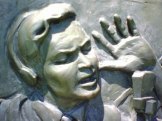Social media’s capacity to demolish media myths soon after they emerge was impressively on display this week as megastorm Sandy swept ashore in New Jersey and disrupted life throughout the Northeast and Mid-Atlantic.
Erroneous reports were many as the storm reached the East Coast on Monday. As the Guardian of London noted today, “the spread of such misinformation was abetted by journalists, who were once taught the importance of verifying every source.”
Notably wrong was the report on CNN’s “Piers Morgan Tonight” news program Monday that Sandy had breached the heart of American capitalism and covered the floor of the New York Stock Exchange in Manhattan with three feet of water.
But that account and a similar report on the hype-prone Weather Channel were promptly disputed, and soon repudiated, in a barrage of posts on Twitter.
In demolishing the bogus reports, Twitter demonstrated a capacity for “savage self-correction,” as John Herrman declared in a post yesterday at the BuzzFeed online site.
Herrman wrote:
“In response to thousands of retweets of erroneous Weather Channel and CNN reports that the New York Stock Exchange had been flooded with ‘three feet’ of water, Twitter users, some reporters and many not, were relentless: photos of the outside of the building, flood-free, were posted. Knowledgeable parties weighed in.”
And the misreporting soon was corrected.
Herrman hailed Twitter as “a fact-processing machine on a grand scale, propagating then destroying rumors at a neck-snapping pace. To dwell on the obnoxiousness of the noise is to miss the result: that we end up with more facts, sooner, with less ambiguity.”
His point is well-taken. On more than a few occasions, Twitter has demonstrated a striking capacity to debunk embryonic media myths — including those myths it helped set loose.
The bogus quotation attributed to the Rev. Dr. Martin Luther King after the slaying last year of terrorist leader Osama bin Laden comes to mind. The made-up passage — “I will mourn the loss of thousands of precious lives, but I will not rejoice in the death of one, not even an enemy” — circulated widely on Facebook and Twitter before their corrective forces effectively demolished it.
But limits to social-media triumphalism must be noted. The corrective power of platforms such as Twitter reaches only so far.
Once established, media myths are exceedingly difficult to uproot. These myths have amply demonstrated that they can withstand the power of social media.

Welles and ‘War of the Worlds’
Take, for example, Halloween’s most famous media myth — the notion that Orson Welles’ War of the Worlds radio dramatization in 1938 touched off nationwide panic and mass hysteria. It’s a hoary media myth that’s just too embedded — and too delicious — to be destroyed.
No amount of Tweeting is likely to dismantle this myth, one of 10 that I debunk in my latest book, Getting It Wrong. It’s too engrained in popular culture — and in the news media — to go the way of CNN’s botched report about the flooded stock exchange floor.
The 74th anniversary of the original broadcast of The War of the Worlds was yesterday and Twitter percolated with reminders about the program and references to the panic it supposedly created. Tweets challenging the narrative of panic and hysteria were in a distinct minority.
Linked to more than a few Tweets yesterday was a tip sheet describing seven lessons that The War of the Worlds dramatization holds for social media.
The tip sheet seems more than a little convoluted, though. Among its observations was this:
“If you are lucky, the publicity often exceeds the actual event …. The panic [of The War of the Worlds program] has become legendary, even though there is quite a bit of evidence to suggest it wasn’t nearly as widespread as reported at the time. But, it put the program on the map, and launched a relatively unknown 23-year old name[d] Orson Welles into the public eye.”
Even that’s not quite true. Although he was 23 at the time of the broadcast, Welles’ had already made the cover of Time magazine.
Recent and related:
- The Internet’s uneven capacity to expose media fakes
- Halloween’s greatest media myth
- Why ‘War of the Worlds’ show didn’t panic America
- More treat than trick: Recalling the ‘War of the Worlds’ radio ‘panic’
- ‘War of the Worlds’ radio panic was overstated
- Katrina and the myth of superlative reporting
- Give the press ‘D-minus’ on post-Katrina coverage
- ABC needs to explain how, why Brian Ross erred so badly
- Jon Krakauer rolls back claims about WaPo ‘source’ in Lynch case
- Those delicious but phony quotes ‘that refuse to die’
- Suspect Murrow quote pulled at Murrow School
- JHistory: ‘Getting It Wrong’ deserves to be ‘required reading’


[…] JOSEPH CAMPBELL ON SOCIAL-MEDIA TRIUMPHALISM, AND SOCIAL MEDIA’S LIMITS. “The corrective power of platforms such as Twitter reaches only so far. Once established, […]
[…] Social media triumphalism and its myth-busting limits […]
[…] yesterday the prospect of “digital wildfires” — how rumor and error spread by social media could give rise to panic and widespread […]
[…] said social media platforms such as blogs and Twitter “have helped us create small cracks in the wall of […]
[…] Social media triumphalism and its myth-busting limits […]